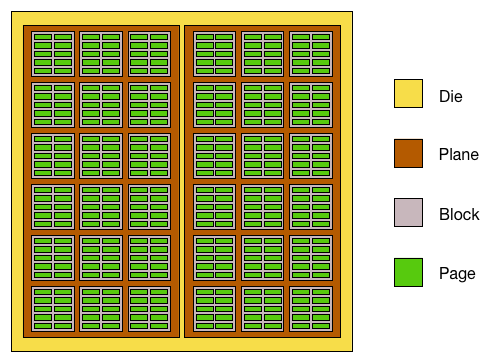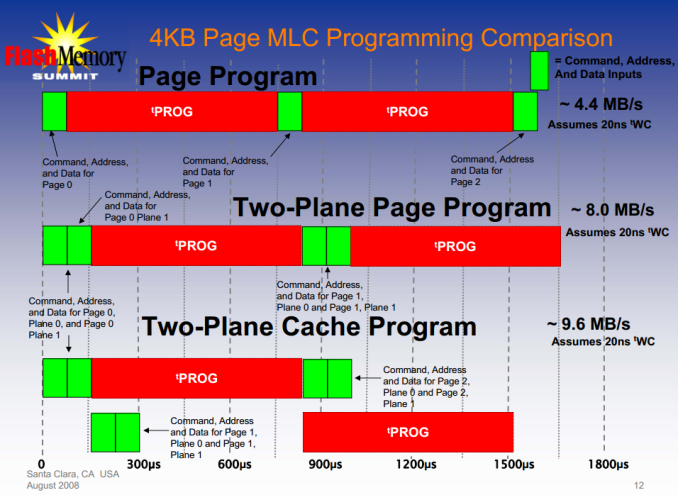Crucial M550 Review: 128GB, 256GB, 512GB and 1TB Models Tested
by Kristian Vättö on March 18, 2014 8:00 AM ESTNAND Lesson: Why Die Capacity Matters
SSDs are basically just huge RAID arrays of NAND. A single NAND die isn't very fast but when you put a dozen or more of them in parallel, the performance adds up. Modern SSDs usually have between 8 and 64 NAND dies depending on the capacity and the rule of "the more, the better" applies here, at least to a certain degree. (Controllers are usually designed for a certain amount of NAND die, so too many dies can negatively impact performance because the controller has more pages/blocks to track and process.) But die parallelism is just a part of the big picture—it all starts inside the die.
Meet the inside version of our Mr. NAND die. Each die is usually divided into two planes, which are further divided into blocks that are then divided into pages. In the early NAND days there were no planes, just blocks and pages, but as the die capacities increased the manufacturers had to find a way to get more performance out of a single die. The solution was to divide the die into two planes, which can be read from or written to (nearly) simultaneously. Without planes you could only read or program one page per die at a time but two-plane reading/programming allows two pages to be read or programmed at the same time.
The reason I said "nearly" is because programming the NAND involves more than just the programming time. There is latency from all the command, address and data inputs, which are marginal compared to the program time but with two-plane programming they take twice the time (you'll still have to send all the necessary commands and addresses separately for both soon-to-be-programmed pages).
I did some rough calculations based on the data I have (though to be honest, it's probably not enough to make my calculations bulletproof) and it seems that the two-plane programming latency is about 2% compared to two individual dies (i.e. it takes 2% longer to program two pages with two-plane programming than with two individual dies). In other words, we can conclude that two-plane programming gives us roughly twice the throughput compared to one-plane programming.
"Okay," you're thinking, "that's fine and all, but what's the point of this? This isn't a new technology and has nothing to do with the M550!" Hold on, it'll make sense as you read further.
Case: M500
| M550 128GB | M500 120GB | |
| NAND Die Capacity | 64Gbit (8GB) | 128Gbit (16GB) |
| NAND Page Size | 16KB | 16KB |
| Sequential Write | 350MB/s | 130MB/s |
| 4KB Random Write | 75K IOPS | 35K IOPS |
The Crucial M500 was the first client SSD to utilize 128Gbit per die NAND. That allowed Crucial to go higher than 512GB without sacrificing performance but also meant a hit in performance at the smaller capacities. As mentioned many times before, the key to SSD performance is parallelism and when the die capacity doubles, the parallelism is cut in half. For the 120/128GB model this meant that instead of having sixteen dies like in the case of 64Gbit NAND, it only had eight 128Gbit dies.
It takes 1600µs to write 16KB (one page) to Micron's 128Gbit NAND. Convert that to throughput and you get 10MB/s. Well, that's the simple version and not exactly accurate. With eight dies, the total write throughput would be only 80MB/s but the 120GB M500 is rated 130MB/s. The big picture is more than just the program time as in reality you have to take into account the interface latency as well as the gains from two-plane programming and cache-mode (the command, address and data latches are cached so there is no need to wait for them between programmings).
Example of cache programming
Like I described above, two-plane programming gives us roughly twice the throughput compared to one-plane programming. As a result, instead of writing one 16KB page in 1600µs, we are able to write two pages with 32KB of data in total. That doubles our throughput from 80MB/s to 160MB/s. There is some overhead from the commands like the picture above shows but thankfully today's interfaces are so fast that it's only in the magnitude of a few percents and in real world the usable throughput should be around 155MB/s. The 120GB M500 manages around 140MB/s in sequential write, so 155MB/s of NAND write throughput sounds reasonable since there is always some additional latency from channel and die switching. Program times are also averages and vary slightly from die to die and it's possible that the set program times may actually be slightly over 1600µs to make sure all dies meet the criteria.
Case: M550
While the M500 used solely 128Gbit NAND, Crucial is bringing back the 64Gbit die for the 128GB and 256GB M550s. The switch means twice the amount of die and as we've now learned, that means twice the performance. This is actually Micron's second generation 64Gbit 20nm NAND with 16KB page size similar to their 128Gbit NAND. The increase in page size is required for write throughput (about 60% increase over 8KB page) but it adds complexity to garbage collection and can increase write amplification if not implemented efficiently (and hence lower endurance).
Micron wouldn't disclose the program time for this part but I'm thinking there is some improvement over the original 128Gbit part. As process nodes mature, you're usually able to squeeze out a little more performance (and endurance) out of the same chip and I'm thinking that is what's happening here. To get ~370MB/s out of the 128GB M550, the program time would have to be 1300-1400µs to be inline with the performance. It's certainly possible that there's something else going on (better channel switching management for instance) but it's clear that Crucial/Micron has been able to better optimize the NAND in the M550.
The point here was to give an idea of where the NAND performance comes from and why there is such dramatical difference between the M550 and M500. Ultimately all the NAND performance characteristics are something the manufacturers won't disclose and hence the figures here may not be accurate but should at least give a rough idea of what is happening at the low level.












100 Comments
View All Comments
Cerb - Sunday, March 23, 2014 - link
It's just that Samsung and Sandisk/Toshiba developed that technology for their flash, and Micron/Intel decided to go all in to making it denser, instead. There's nothing "Pro" about the 840, nor Toshiba's Q, with a, "Pro," after them, other than the name. Hell, gaming video cards have had "Pro" suffixes.Samsung and Toshiba/Sandisk decided to develop and use that kind of technology (it's in the Q series, with no marketing at all, and in Sandisk's Ultra Plus (X110?) and Extreme II (X210?) as ncache), while Intel/Micron went all in for density and cost, instead.
It's generally useful, as it can allow a first stage of buffering to fake SLC, so live data writes generate less wear. So, bursty writes and random writes can both perform better, and wear the flash out less, than if it were pure TLC or MLC. I suspect it will find its way into server products over the next few years, as well, if it's not already hiding in something of Toshiba's.
Also, just as there's been increased demand for 7200 RPM SATA and SAS for professionals, plain SATA SSDs are all most users need, as well. Pro users are using the same classes of drives as consumers, for the most part.
JBVertexx - Tuesday, March 18, 2014 - link
I also agree this is positioned as a mainstream drive but with the additional performance and features upping the ante.It's hard to argue with price. The last several SSDs I have purchased have been the M500 240GB model. The current price of the 550 is what the 500 was only 3 months ago. So I would expect the positioning of the 550 to continue the price/value leadership position as it eventually replaces the M500. My bet is that the volumes of M500s that have been selling for them support this positioning as a winning one for Crucial.
MrSpadge - Tuesday, March 18, 2014 - link
Agreed - the M500 is really putting price pressure on everyone else. For this benefit I can live with slightly lower performance. If M550 at 120/240 GB comes even close in price it's a default win. It has to be cheaper than 840 Evo, though.trichome333 - Wednesday, March 19, 2014 - link
Agreed, just got a 240gb M500 for $115. Read is up there with any SSD which is all I care about.laviathan05 - Tuesday, March 18, 2014 - link
On a personal note, as a person who bought a new Samsung EVO 1TB drive yesterday, I'm pleased with this review. Also, if you follow the link in the pricing chart you'll see that it currently is selling for $470 on newegg.Jaguar36 - Tuesday, March 18, 2014 - link
In your final words you mention that "It has the best-in-class encryption support", How come you don't say anything else about this in the article? What exactly does best in class mean?Kristian Vättö - Tuesday, March 18, 2014 - link
"There is TCG Opal 2.0 and IEEE-1667 support, which are the requirements for Microsoft's eDrive encryption."It's something we've covered before so I only mentioned it in the review. Clicking the eDrive link leads to an article where the M500 is tested with eDrive, so you'll see the benefits there.
Jaguar36 - Tuesday, March 18, 2014 - link
Thanks!just4U - Tuesday, March 18, 2014 - link
When looking at SSD's to purchase I settled on 3 Intel, Samsung, and Crucial. The controller on the Intel and the fact that it was priced in the range of the Samsung led to me dropping it as a choice. So that left me with Samsung/Crucial. Given the choice I'd go Samsung.. as it is a higher performing drive but price/availability I wouldn't be to terrible upset if I had to go with the Crucial drives.I think maybe they just let performance take a back seat because their other drive was popular even though it was slower than the rest of the pack. It gained a good reputation so their hoping that will carry over to this new slightly faster/feature rich incarnation.
extide - Tuesday, March 18, 2014 - link
Were you talking an Intel SF drive (300/500 series?) or the 720, with the super sweet in-house controller? Also don'[t forget about the Sandisk Extreme II...IMO The Top Tier performance drives are (In no specific order):
Sandisk Extreme II
Intel 720 Series
Crucial Neutron GTX
Samsung 840 Pro
Seagate 600
OCZ Vector 150
And the best in terms of capacity/price:
Crucial M500 (& M550?)
Samsung 840 EVO